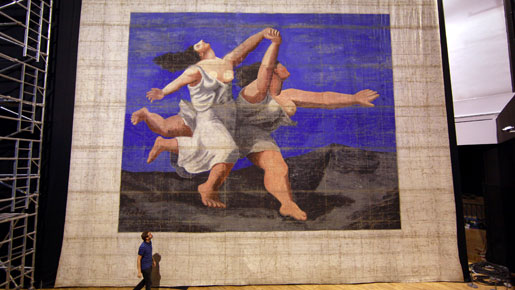
You would expect a major show of the work of the greatest artist of the twentieth century to take a great deal of planning, but nigh on half a lifetime seems a bit excessive. But then Picasso: Peace and Freedom is no ordinary retrospective, but a complete rethinking of the way the Spanish artist’s political life influenced his later work.
It was in the late 1970s that acclaimed art historian Lynda Morris learned that Picasso – or, to give him his full name, Pablo Diego José Francisco de Paula Juan Nepomuceno María de los Remedios Cipriano de la Santísima Trinidad Ruiz y Picasso – visited Sheffield for an international peace conference in 1950. Morris’s curiosity was peaked but she had difficulty finding any further information about the trip – Picasso’s only post-war visit to England – in any of the standard writings on the artist available at the time. She only got to grips with the full story after accessing newspaper articles written about the conference, which never actually went ahead because so many of the delegates were refused entry to the UK.
Years of research followed, including several months at the Musée National Picasso in Paris, where she discovered an “intriguing set of boxes” that had been discounted by other researchers as “general rubbish”. Those boxes turned out to contain political correspondence received by Picasso between the end of the Second World and his death in 1973 that, according to Morris, offers many profound insights into the way that we view Picasso’s post-war work.
“I went from the material that I found in the Picasso archive into proper histories of the period and then…I started to look at Picasso’s paintings in the post-war period and the way in which this political background suggested all sorts of meaning that hadn’t ever emerged.”
The exhibition will feature over 150 pieces, from large-scale paintings to pin badges depicting Picasso’s dove, the symbol adopted by the international peace movement. It will also contain a great deal of documentary material that Morris hopes will enrich viewers’ understanding of the works presented to them.
Las Meninas, a series of paintings completed in the second half of 1957, is particularly illuminating when it comes to understanding the extent to which Picasso’s work was influenced by his politics. The original Las Meninas is an extremely well known work by the seventeenth century Spanish painter, Diego Velázquez, which shows the artist himself at work at the court of King Philip IV, alongside a group that includes the child princess Margarita and various retainers.
Picasso’s versions have previously been read as a celebration of the “heroic Velázquez tradition”, but Morris’s research has allowed her to develop a different take on the series. She cites a number of clues: the dangerous-looking hooks in the ceiling represent the 130-year sentences handed down to political prisoners by the Franco regime; one of the dwarves has been given a Franco-style moustache; the colour scheme of some of the series recalls the red and blue of the extreme fascist group, the Falangists; and the list goes on.
For Morris, this series is an explicit and condemnatory commentary on Franco’s Spain in the post-war period and she hasn’t “found anyone yet who hasn’t thought that it’s an extraordinarily accurate interpretation of the pictures”.
Among the other major works re-examined in the show are The Charnal House (1944-45) and The Rape of the Sabine Women (1962), which Morris reads as responses to the Spanish Civil War and the Cuban Missile Crisis respectively.
As well as increasing our understanding of Picasso’s works, this show, through its examination of his political preoccupations, will also serve to debunk some of our erroneous ideas of what Picasso was like as a man. The great artist, who we have come to think of as selfish and self-obsessed, was committed to supporting Spanish Republican refugees, funding hospitals and orphanages for them in the south of France following the Spanish Civil War.
Picasso joined the French Communist Party in 1944, but this decision was not down to any particular love for the movement as such, but rather a response to his anger over what Franco’s fascist regime was doing to his beloved homeland. It was joining the Communist Party that then led him to play important roles in the international peace movement, the anti-apartheid movement and the civil rights movement in the United States. Morris acknowledges a major change in her own thinking about him. “I always had the idea of him as a bit of a womaniser, lounging around beaches in the south of France, but I hadn’t understood the extent of his passion for Spain”.
Picasso: Peace and Freedom will be running at Tate Liverpool, Liverpool, UK from 21 May to 30 August. www.tate.org.uk
Image: Pablo Picasso
The Charnel House, Paris, 1944-1945, dated 1945
© Succession Picasso/DACS 2009
© 2009 Digital image, The Museum of Modern Art New York/Scala, Florence.

